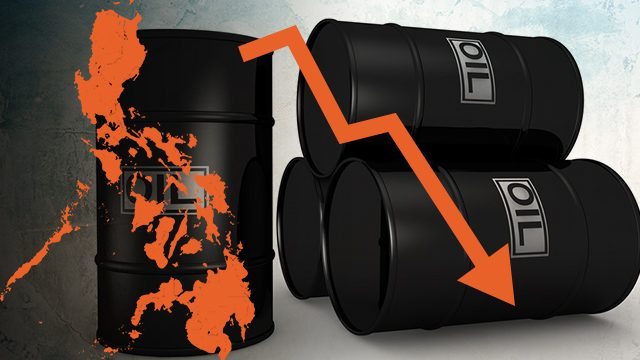SUMMARY
This is AI generated summarization, which may have errors. For context, always refer to the full article.

MANILA, Philippines – Ask any stockbroker or economist what’s keeping them up at night and chances are you’ll get the reply: the oil price.
It would come as no surprise as well since the plummeting price of oil has been the main economic story coming into the new year.
The International Energy Agency (IEA) recently released a report saying that the oil market could drown in over-supply. At one point, US and global benchmarks traded under $27, the lowest level the world has seen since 2003.
Just 18 months ago, oil was trading at $110 a barrel.
Global crude oil’s steady drop has also spooked global markets, and institutions such as the International Monetary Fund (IMF) have cited it as one of the main reasons for gloomy growth worldwide this year. (READ: IMF cuts world growth forecast, warns of major risks)
Low oil prices hurt the economies of major producers such as majority of the Middle East, Russia, and Brazil. The latter two are already in recession, which has a knock-on effect on global growth.
Analysts also worry that low prices are a signal of slower growth in developing nations, notably China, which managed to keep oil prices up almost single-handedly last year. Beijing’s economic slowdown in 2015 – dubbed the “new normal” – is seen as another cause of concern.
Still, while producers are hurting, consumers should be happy as one of the main benefits of low oil prices are felt at the pump in the form of cheaper gas or diesel.
Spurring Filipinos’ consumption
The Philippines, which imports majority of its crude oil and features an economy built on consumer spending, stands to gain more than most.
“The country imports oil and production cost in many industries will be driven down by low oil prices. A growing domestic economy will serve as buffer against slowdown in countries producing oil. It will boost purchasing power and strengthen domestic markets,” said Cid Terosa, Vice Dean of the Economics Program at the University of Asia and the Pacific (UA&P).
Aside from gas prices, the prices of utilities like electricity will stabilize too, Terosa added.
The country upped its crude oil imports in 2014 to 64.938 million barrels, an increase of 15.3% from 2013 levels.
Another benefit of the prices will be keeping a lid on for consumers.
“Low oil prices feed into the overall price level and thus inflation has been generally tame, helping overall consumption,” said Nicholas Mapa, a research officer at Bank of the Philippine Islands (BPI) Global Markets.
The Bangko Sentral ng Pilipinas (BSP) recently announced that inflation settled at 1.4% for 2015, well below its target of 2% to 4%.
In the medium term, low inflation rates help the BSP keep interest rates low, which will further spur consumption and investment, Mapa explained.
The economists agreed that most of the country’s manufacturing, mining, and even trade industries would benefit from the situation as production costs would go down.
Mapa noted that transportation would also be a winner, especially airlines, given that fuel costs make up a good portion of their expenses.
“Automobile companies and motorcycle companies may also benefit as low oil prices make it attractive to own vehicles,” he said.

Continued market volatility, OFW concerns
While Filipinos might be spending their way to a stronger economy, economists aren’t optimistic about the stock markets.
“As long as oil prices remain subdued, risk sentiment will be absent and financial markets will remain pressured,” said Mapa.
He also believes that the current oil prices are largely caused by Saudi Arabia and other OPEC nations driving up supply to eliminate new shale gas competitors and competition from archrival Iran.
“The longer they hold out and pump more oil, the worse off it’ll be for oil players. I see a reversal in OPEC policy in the coming months which should help support prices as demand for oil is still apparent,” Mapa said.
Terosa, for his part, thinks that financial markets will eventually adjust to this new normal. “In the transition, however, volatility will be the norm in financial markets.”
As for oil prices, Terosa predicts they will eventually stabilize, but below $50 a barrel.
Bernardo Villegas, research director of the Center for Research and Communication (CRC) and co-founder of UA&P, gave a gloomier assessment. “Financial markets will be depressed for the whole of 2016 not only because of low oil prices, but because of the slowdown of China and other emerging markets like Brazil and Russia.”
Aside from roiling global markets, low oil prices could also have a more direct effect on the Philippines due the substantial number of overseas Filipino workers (OFWs) based in the Middle East.
This is because the remittances that OFWs send directly fund consumption of their families as well as provide the BSP a stable source of dollars and other hard currencies.
“The prolonged low prices may be taking its toll on economies in the Middle East, which may lead to cuts in salaries for OFWs and worse yet, outright layoffs. Should this happen, we may see a slowdown in our remittance flows, which is integral to our growth engine,” Mapa noted.
Window for infrastructure
Despite a small rally that saw both North American and global benchmarks breach the $30 a barrel mark at the close of trading on Friday, January 22, reaching even $50 a barrel seems out of reach for the immediate future.
Experts noted that this creates favorable conditions for the improvement of the Philippines’ creaking infrastructure.
The current environment is helping the BSP keep interest rates low as global rates have remained subdued as well even in the face of the US Federal Reserve rate hike, Mapa said.
This in turn means lower financial costs for projects, giving the government a window in which it can spend to enhance the country’s infrastructure in time for a rise in both interest rates and energy prices, he added.
Villegas echoed this, saying that “we should spend on both government and public private partnerships (PPPs) even if the fiscal deficit increases to more than 2 or 3%.”
Given the conditions at the moment, he added that “we should also keep interest rates down for the whole of 2016.” – Rappler.com
Add a comment
How does this make you feel?
There are no comments yet. Add your comment to start the conversation.